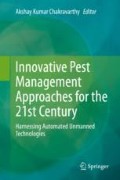Abstract
Pesticide-risk-analysis (PRA) is a key area in toxicology with wider relevance to horticultural crops. Though the pesticide consumption is comparatively low in developing countries like India, than developed nations, the unscrupulous and unscientific usage is the culprit. This makes commodities laden with pesticides exceeding the permissible limits, posing potential problem to human health and the non-targets. Reduced-risk pesticides with PHI, biosafety aspects to pollinators, safe waiting periods must be given due importance, and control interventions must be initiated based on Economic Threshold Level (ETL). Role of GAP in PRA is deliberated, with relevant information and examples. Robust crop management practices and good agricultural practices, vigilant monitoring system is necessary. Rapid in situ techniques must be developed to residues and contaminants in the concerned commodities. It is assumed that a strong extension system supported by ICT sector is necessary to accomplish the task.
Access this chapter
Tax calculation will be finalised at checkout
Purchases are for personal use only
References
AINP on Pesticide Residues (2013) Monitoring of pesticide residues at National level. Annual Report (2011-2012). ICAR-IARI, New Delhi
AINP on Pesticide Residues (2015) Monitoring of pesticide residues at National level. Annual Report (2013-2014). ICAR-IARI, New Delhi
Akter M, Fan L, Rahman MM, Geissen V, Ritsema CJ (2018) Vegetable farmers’ behaviour and knowledge related to pesticide use and related health problems: a case study from Bangladesh. J Clean Prod 200:122–133
Awasthi MD (1986) Chemical treatments for the decontamination of brinjal fruit from residues of synthetic pyrethroids. Pestic Sci 17(2):89–92
Bhushan C, Bhardwaj A, Misra SS (2013) State of pesticide regulations in India. Centre for Science and Environment, New Delhi, pp 1–72
Brittain CA, Vighi M, Bommarco R, Settele J, Potts SG (2010) Impacts of a pesticide on pollinator species richness at different spatial scales. Basic Appl Ecol 11(2):106–115
Cai DW (2008) Understand the role of chemical pesticides and prevent misuses of pesticides. Bull Agric Sci Technol 1(6):36–38
Coslor CC, Vandervoort C, Wise JC (2019) Insecticide dose and seasonal timing of trunk injection in apples influence efficacy and residues in nectar and plant parts. Pest Manag Sci 75(5):1453–1463
DARE (2015) DARE/ICAR annual report, 2014-15. pp 1–103
Devos Y, Romeis J, Luttik R, Maggiore A, Perry JN, Schoonjans R, Brock TC (2015) Optimising environmental risk assessments. EMBO Rep 16(9):1060–1063
Doris MS, Ramesha N, Karanth NGK (1990) Insecticide contamination in groundnuts and biological methods for cleaning. In: Shetty HS, Prakash HS (eds) Proc. Adv. Seed Sci. Technol. (UGC-DRS), Mysore, pp 368–371
FICCI (2013) Indian Agrochemical Industry: imperative of growth. 3rd National Agrochemical conclave
IRAC (Insecticide Resistance Action Committee) (2007) IRAC mode of action classification revised and re-issued, July 2007. www.irac-online.org
Jankowska M, Łozowicka B, Kaczyński P (2019) Comprehensive toxicological study over 160 processing factors of pesticides in selected fruit and vegetables after water, mechanical and thermal processing treatments and their application to human health risk assessment. Sci Total Environ 652:1156–1167
Karanth NGK (1992) Abatement of pesticide residues through biodegradation. In: Agrawal VP, Rana SVS (eds) Environment and biodegradation. Society of Biosciences, Muzaffarnagar, pp 243–252
Karanth NGK, Jayaram M, Majumder SK (1982a) Insecticidal residue in vegetables obtained from soil treated with hexachlorocyclohexane. J Food Sci Technol 19(1):14–19
Karanth NGK, Srimathi MS, Majumder SK (1982b) A chromogenic paper for ultrarapid detection of organochlorine insecticide residues in vegetables. Bull Environ Contam Toxicol 28(2):221–224
Karanth NGK, Jayaram M, Majumder SK (1983a) Observations on the growth and residue levels of insecticide in vegetable plants raised on hexachlorocyclohexane treated soil. Comp Physiol Ecol 8(4):357–361
Karanth NGK, Srimathi MS, Majumder SK (1983b) Insecticide fingerprinting technique for detection and location of organochlorine insecticide residues in foods. J Environ Sci Health B 18(6):745–755
Mahapatro GK, Behera TK (2009) Integrated pest management in vegetable crops. In: Kalia P, Subodh J, Behera TK, Sushil P (eds) Vegetable variety development and evaluation. IARI, New Delhi, pp 163–169, 256 p, Training sponsored by FAO, 15 Sept 2009 to 14 Oct 2009
Mahapatro GK, Birah A, Gupta GP (2008) Pesticides in India: the tangible trends. Indian J Entomol 70(1):1–11
Mandal K, Singh B (2010) Magnitude and frequency of pesticide residues in farmgate samples of cauliflower in Punjab, India. Bull Environ Contam Toxicol 85(4):423–426
Pimentel D (2009) Pesticides and pest control. In: Rajinder P, Dhawan A (eds) Integrated pest management: innovation-development process, vol 1. Springer, pp 83–87
Rai AB (2014) Integrated pest management for vegetable crops. Indian Institute of Vegetable Research, Varanasi
Sanchez-Bayo F, Goka K (2014) Pesticide residues and bees—a risk assessment. PLoS One 9(4):e94482
Sitaramaraju S, Prasad NVVSD, Reddy VC, Narayana E (2014) Impact of pesticides used for crop production on the environment. J Chem Pharm Sci 3:75–79
Skerritt JH (1998) Appropriate analytical technologies for monitoring agrochemical residues. In: Kennedy IR, Skerritt JH, Johnson GI, Highley E (eds) Proceedings of ACIAR, No. 85. Seeking agricultural produce free of pesticide residues, pp 37–45
The Indian Express, 5 Jan 2015
Vaughan M, Ferruzzi G, Bagdon J, Hesketh E, Biddinger D (2014) Preventing or mitigating potential negative impacts of pesticides on pollinators using integrated pest management and other conservation practices. Agronomy Technical Note No. 9, Feb 2014, pp 1–24
Acknowledgement
The authors are grateful to the authorities of ICAR-Indian Agricultural Research Institute, New Delhi, for their support and encouragement.
Author information
Authors and Affiliations
Editor information
Editors and Affiliations
Rights and permissions
Copyright information
© 2020 Springer Nature Singapore Pte Ltd.
About this chapter
Cite this chapter
Mahapatro, G.K., Rajna, S. (2020). Insecticide Toxicity and Pesticide Residues in Horticultural Crops. In: Chakravarthy, A. (eds) Innovative Pest Management Approaches for the 21st Century. Springer, Singapore. https://doi.org/10.1007/978-981-15-0794-6_18
Download citation
DOI: https://doi.org/10.1007/978-981-15-0794-6_18
Published:
Publisher Name: Springer, Singapore
Print ISBN: 978-981-15-0793-9
Online ISBN: 978-981-15-0794-6
eBook Packages: Biomedical and Life SciencesBiomedical and Life Sciences (R0)

